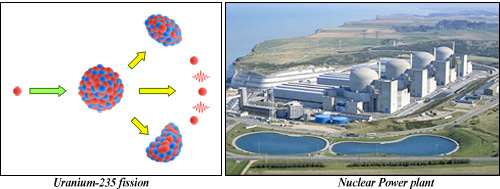Fission and Nuclear energy
The fission of the atomic nucleus is a natural phenomenon that releases, at the atom scale, millions times more energy than in the other sources of energy used by mankind. Discovered in 1938, the fission of rare heavy nuclei such as uranium-235 and plutonium-239, is triggered by the capture of one neutron. The nucleus then splits in two highly radioactive fragments, releasing energy and producing new neutrons.
These neutrons trigger in turn other fissions, propagating the process from fissile nucleus to fissile nucleus and generating a chain reaction that, if not controlled, may lead to the explosion of an atomic bomb or an accident. For the production of electricity, all the art of the engineers consists in harnessing this chain reaction in reactors in order to stretch out the release of energy over months and years.
Fission power is an attractive resource of energy, abundant and almost unlimited with the option of breeder reactors. Nuclear reactors do not emit greenhouse gases and do not contribute to climatic change. Contrarily to windmills and solar energies, it is not intermittent. Nuclear power points are powerful.
A very high level of safety is required to operate reactors in order to avoid accidents. Only developed and great nations, like China and India, have reached the necessary know-how. Nuclear power generates also waste that are small in volume but highly radioactive, whose management necessitates the greatest cares.
This impressive source of energy, much valued by some, feared by others, cannot be put in everybody’s hands. The distinction between the civilian and military atom is tenuous! Access to the nuclear technology should be strictly organized to avoid proliferation. However, it will be probably necessary in the years to come to draw on the fabulous amounts of energy hidden in uranium atoms to meet the huge needs of developing countries. It is no surprise that most of the new reactors under construction are now in Asia.

Fission and nuclear energy
From the internal energy of uranium nuclei to nuclear plants
© IN2P3
ACCESS TO CHAPTERS : SUMMARY
– Nuclear fission : Principles of nuclear fission. Chain reaction. Role of neutrons. Fission products and actinides.
– Nuclear power plants and reactors : Types of reactors. Pressurized water reactors (PWR). Control and safety of reactors.
– Nuclear fuels for reactors : Nuclear fuels for PWR. Uranium-235, the only fissile natural nucleus. Isotopes separation and uranium enrichment. Mixed fuels with plutonium.
– Reactors for tomorrow : EPR and projects of fourth generation reactors. . Accelerator driven systems (waste burners).
– Military Applications : Nuclear weapons and the military atom – A testimony from Nagasaki. Past nuclear tests. Status of the dismantling of cold war arsenals. Proliferation problems. The Iranian crisis.
– Nuclear accidents (military and civilian) : Accident of Mayak and Windscale (1950s). Three Mile Island.
– Chernobyl (1986) : Circonstances. Radioactive releases. et Contaminations. Health effects. Chernobyl today
– Fukushima (2011) : Events and cause. Radioactive releases. Contaminations and decontaminations. Health effects. Fukushima today
– The nuclear fusion : The ITER project